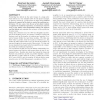Free Online Productivity Tools
i2Speak
i2Symbol
i2OCR
iTex2Img
iWeb2Print
iWeb2Shot
i2Type
iPdf2Split
iPdf2Merge
i2Bopomofo
i2Arabic
i2Style
i2Image
i2PDF
iLatex2Rtf
Sci2ools
IWPSE
2007
IEEE
2007
IEEE
Improving defect prediction using temporal features and non linear models
Predicting the defects in the next release of a large software system is a very valuable asset for the project manger to plan her resources. In this paper we argue that temporal features (or aspects) of the data are central to prediction performance. We also argue that the use of non-linear models, as opposed to traditional regression, is necessary to uncover some of the hidden interrelationships between the features and the defects and maintain the accuracy of the prediction in some cases. Using data obtained from the CVS and Bugzilla repositories of the Eclipse project, we extract a number of temporal features, such as the number of revisions and number of reported issues within the last three months. We then use these data to predict both the location of defects (i.e., the classes in which defects will occur) as well as the number of reported bugs in the next month of the project. To that end we use standard tree-based induction algorithms in comparison with the traditional regress...
IWPSE 2007 | Non-linear Models | Software Engineering | Temporal Features | Traditional Regression |
| Added | 04 Jun 2010 |
| Updated | 04 Jun 2010 |
| Type | Conference |
| Year | 2007 |
| Where | IWPSE |
| Authors | Abraham Bernstein, Jayalath Ekanayake, Martin Pinzger |
Comments (0)

